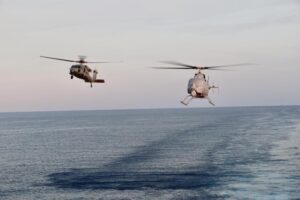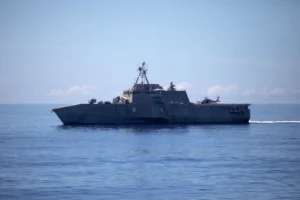The USS Jackson (LCS-6) Independence-variant Littoral Combat Ship conducted over two dozen flight hours with the MQ-8C Fire Scout unmanned aerial vehicle during a recent deployment in the Western Pacific region, including significant manned-unmanned teaming (MUM-T).
LCS-6 returned to its homeport of San Diego on Oct. 15 following its first deployment that started July 11, 2021. While at sea, the ship conducted patrols throughout Oceania and the South China Sea.

Ship and fleet leaders boasted that the Jackson’s work with the Fire Scout was successful, leading to about 28 hours of flight operations.
“We had a lot of success with the Fire Scout…pushing out relay distances out in excess of 100 miles, which is great news. Additionally, at the beginning of next year, we have some [Naval Air Systems Command] operations scheduled, looking at expanding the wind pitch and roll restrictions that are currently on the Fire Scout. But absolutely a force multiplier in theater,” Cmdr. Michael Winslow, commanding officer of Jackson’s Blue crew, told reporters during a press call on Oct. 19.
The Northrop Grumman [NOC] MQ-8C, based on the Bell Textron [TXT] 407 commercial helicopter airframe, is meant to help supplement the Sikorsky [LMT] MH-60 Seahawk provide maritime intelligence, surveillance, reconnaissance and targeting (ISR&T). This newest version of the Fire Scout features a larger payload and higher endurance.
Capt. Marc Crawford, commodore of Littoral Combat Ship Squadron One, also told reporters LCS-6 was the first ship to deploy with the MQ-8C variant of the unmanned helicopter.
In May, Northrop Grumman noted this first deployment to the Indo-Pacific region earlier this year. The company said it can provide over 10 hours on endurance at a time with a range of over 1,000 nautical miles (Defense Daily, May 24).
The MQ-8C was initially deployed on the USS Milwaukee (LCS-5) in the Caribbean Sea in January (Defense Daily, Jan. 24).
Cmdr. John Van Wagoner, executive officer of Jackson’s Gold crew, also told reporters that the ship’s operations with the MQ-8C in the 7th Fleet area of operations “really defined what persistent operations with the M-Q8 Charlie looks like. As a result of that, I think our operational commanders are seeking new ways to employ that sensor alongside other unmanned aircraft and surface vehicles.”
Van Wagoner confirmed the ship conducted numerous successful manned-unmanned teaming exercises with both helicopters. This included about a dozen exercises with over 100 hours of MQ-8C operations while forward deployed.
“While conducting those manned unmanned teaming operations, what we found was that having a an unmanned aircraft that had many very capable sensor payloads was really a force multiplier that we could use to develop our recognized air and maritime picture beyond the horizon while using the MH-60 Sierra to conduct positive identification of things that we detected with the MQ-8 Charlie,” he said.
Van Wagoner also noted the crew used the MQ-8C’s surface search radar, an electro-optical infrared camera, and a link to connect those to Jackson’s combat system to share that information with other ships.
He said the camera operations were also used to “continue to drive down the classification problem for the things that we found when leveraging that platform.”
Previously, in March the Navy and Marine Corps announced they performed a MUM-T exercise with UH-1Y Venom and AH-1Z Viper helicopters conducting attacks with a Helicopter Sea Combat Squadron 23 (HSC-23) MQ-8C Fire Scout unmanned helicopter operating via a ground control station to aid target decision and strike coordination (Defense Daily, March 16).

When asked what they would like to see with unmanned systems going forward, Van Wagoner said just pushing to continue to develop these kinds of capabilities and “developing the things that we field on those platforms to enable us to do it in a more integrated way would be really meaningful and significant.”
While underway, Van Wagoner confirmed LCS-6 operated with the surface warfare mission package, largely consisting of the Kongsberg and Raytheon Technologies’ [RTX] Naval Strike Missile, the MQ-8C, and “some additional combat systems and weapon systems that make that ship effective in a Surface Warfare domain.”
Notably, this deployment occurred on a ship the Navy plans to inactivate in fiscal year 2024, pending the congressional defense policy bill.
The service’s 30-year shipbuilding plan outlined plans to retire 24 ships in FY ‘23 to save $3.6 billion over the next five years as well as other decommissionings planned over the next five years (Defense Daily, April 25).
The Jackson was commissioned in 2015 and, if inactivated as planned, will have only served for under a decade.
Crawford said, however the Navy plans and Congress’ bill work out, “we will continue to use Jackson as long as we are allowed to.”
“She has been operating forward for the last 15 months and doing a superlative job while doing it. And as long as we can keep her around, we will. There are decisions to be made in the budgeting circles in D.C. That’s beyond our purview here, but as long as we have them we will operate to their full potential,” he continued.
For now, Crawford said the Navy is planning for LCS-6 to go down from the dual blue-gold crew to a single crew on the way to inactivation, but that will not occur until they get final authorization from the defense authorization bill.
“So we are making those plans to go down to a single crew. However, as we’ve seen in the past, sometimes we change direction and we pivot in these negotiations, and so we’re not taking any actual steps to reduce, but the plans are codified,” Crawford said.
Otherwise, he said until the ship is inactivated, “there’s a lot of great work that we will use Jackson to do as is we support rotational deployers as they’re going out the door, whether it be through exercises or other events,” he added.